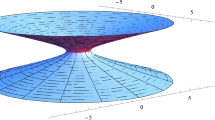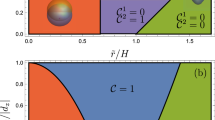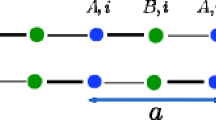Abstract
In this paper, a discussion about quantum holonomies around a possible bridge between two graphene sheets has been made. That bridge is widely known as a graphene wormhole, and some of its characteristics are also showed up here. As well as their build as a zigzag junction between a baggy nanotube and the graphene lattices. And how the localized electronic states could be mimicked by gauge fields in a low-energy regime. Further, the possibility to build holonomies handle by an effective flux from topological defects in junctions of that bridge has been discussed.
Similar content being viewed by others
Data Availability Statement
Data sharing not applicable to this article as no datasets were generated or analyzed during the current study.
References
R. Jackiw, Lower dimensional gravity. Nucl. Phys. B 252, 343 (1985)
S. Deser, R. Jackiw, Three-dimensional einstein gravity: dynamics of flat space, G. ’t Hooft. Ann. Phys. (N. Y.) 152, 220 (1984)
M.I. Katsnelson, Graphene - carbon in two dimensions (Cambridge University Press, 2012)
H. Suzuura, T. Ando, Crossover from symplectic to orthogonal class in a two-dimensional honeycomb lattice. Phys. Rev. Lett. 89, 266603 (2002)
A. Fasolino, J.H. Los, M.I. Katsnelson, Intrinsic ripples in graphene. Nature Materials 6, 858–861 (2007)
M.I. Katsnelson, A.K. Geim, Electron scattering on microscopic corrugations in graphene. Philos. Trans. R. Soc. A 366, 195 (2008)
V. Volterra, Sur l’équilibre des corps élastiques multiplement connexes. Annales scientifiques de l’École normale supérieure 24, 401–517 (1907)
M.O. Katanaev, I.V. Volovich, Theory of defects in solids and three-dimensional gravity. Ann. Phys. 216(1), 1–28 (1992)
I.V. Fialkovsky, D.V. Vassilevich, Quantum field theory in graphene. Int. J. Mod. Phys. A 27(15), 1260007 (2012)
H.W. Kroto, J.R. Heath, S.C. O’Brien, R.F. Curl, R.E. Smalley, C60: Buckminsterfullerene. Nature 328, 162 (1985)
J. Gonzalez, F. Guinea, M.A.H. Vozmediano, Continuum approximation to fullerene molecules. Phys. Rev. Lett. 69, 1 (1992)
J. Gonzalez, F. Guinea, M.A.H. Vozmediano, The electronic spectrum of fullerenes from the Dirac equation. Nucl. Phys. B 406, 771 (1993)
E. Cavalcante, C. Carvalho, Geometric model for Fullerene Molecule in the presence of Aharonov-Bohm flux. J. Phys. Chem. Solids 75, 1265–1268 (2014)
G.Q. Garcia, E. Cavalcante, A.M. de M. Carvalho, C. Furtado, The geometric theory of defects description for \(C_{60}\) fullerenes in a rotating frame. Eur. Phys. J. Plus 132, 183 (2017)
J. Gonzalez, J. Herrero, Graphene wormholes: a condensed matter illustration of Dirac fermions in curved space. Nucl. Phys. B 825, 426–443 (2010)
G.D. Garcia, P.J. Porfírio, D.C. Moreira, C. Furtado, Graphene wormhole trapped by external magnetic field. Nucl. Phys. B 950, 114853 (2020)
A. Einstein, N. Rosen, The particle problem in the general theory of relativity. Phys. Rev. 48(1), 73 (1935)
M.S. Morris, K.S. Thorne, Wormholes in spacetime and their use for interstellar travel: a tool for teaching general relativity. Amer. J. Phys. 56, 395 (1988)
J. Gonzalez, F. Guinea, J. Herrero, Propagating, evanescent, and localized states in carbon nanotube-graphene junctions. Phys. Rev. B 79(16), 165434 (2009)
T.F. Souza, A.C.A. Ramos, R.N. Costa Filho, J. Furtado, Generalized Ellis-Bronnikov graphene wormhole, e-print arXiv:2208.06869 (gr-qc) (2022)
J.E.G. Ramos, J. Furtado, T.M. Santiago, A.C.A. Ramos, D.R. da Costa, Electronic properties of bilayer graphene catenoid bridge. Phys. Lett. A 384, 126458 (2020)
H. Kleinert, Gauge fields in condensed matter (World Scientific, Berlim 2, 1989)
A. Bohm, A. Mostafazadeh, H. Koizumi, Q. Niu, J. Zwanziger, The geometric phase in quantum systems: foundation, mathematical concepts and applications in molecular and condensed Matter Physics Springer, New-York (2003)
P. Zanardi, M. Rasetti, Holonomic quantum computation. Phys. Lett. A 264, 94–99 (1999)
V.I. Kuvshinov, A.V. Kuzmin, Stability of holonomic quantum computations. Phys. Lett. A 316, 391–394 (2003)
C. Monroe, D.M. Meekhof, B.E. King, W.M. Itano, D.J. Wineland, Demonstration of a fundamental quantum logic gate. Phys. Rev. Lett. 75, 4714 (1995)
J. Pachos, Topological features in ion-trap holonomic computation. Phys. Rev. A 66, 042318 (2002)
M. Cholascinski, Quantum holonomies with Josephson-junction devices. Phys. Rev. B 69, 134516 (2004)
A. Recati, T. Calarco, P. Zanardi, J.I. Cirac, P. Zoller, Holonomic quantum computation with neutral atoms. Phys. Rev. A 66, 032309 (2002)
J. Pachos, S. Chountasis, Optical holonomic quantum computer. Phys. Rev. A 62, 052318 (2000)
K. Bakke, C. Furtado, S. Sergeenkov, Holonomic quantum computation associated with a defect structure of conical graphene. Europhysics Letters 87, 30002 (2009)
J.A. Jones, V. Vedral, A. Ekert, G. Castagnoli, Geometric quantum computation using nuclear magnetic resonance. Nature 403, 869871 (2000)
J. Teles et al., Experimental implementation of quantum information processing by Zeeman-perturbed nuclear quadrupole resonance. Quantum Inf. Process 14, 18891906 (2015)
E. Cavalcante, C. Furtado, Quantum Holonomy based in a Kaluza-Klein description for defects in \(C_{60}\) fullerenes. Int. J. Geom. Methods Mod. Phys. 18(10), 2150163 (2021)
C. Bena, G. Montambaux, Remarks on the tight-binding model of graphene. New J. Phys. 11(9), 095003 (2009)
M. Visser, Lorentzian Wormholes: from Einstein to Hawking, AIP (1995)
C.W. Misner, J.A. Wheeler, Classical physics as geometry. Annals Phys. 2, 525 (1957)
H.G. Ellis, Ether flow through a drainhole: a particle model in general relativity. J. Math. Phys. 14(1), 104–118 (1973)
K.A. Bronnikov, Scalar-tensor theory and scalar charge. A. Phys. Pol. B 4, 251–266 (1973)
M.S. Morris, K.S. Thorne, U. Yurtsever, Wormholes, times machines and weak energy conditions. Phys. Rev. Lett. 61, 1446–1449 (1988)
N. Godani, G.C. Samanta, Non violation of energy conditions in wormholes modeling. Mod. Phys. Lett. A 34(28), 1950266 (2019)
N. Godani, D.V. Singh, G.C. Samanta, Phys. Dark Univ. 35, 100952 (2022)
K. Sasaki, J. Jiang, R. Saito, S. Onari, Y. Tanaka, Theory of superconductivity of carbon nanotubes and graphene. J. Phys. Soc. Jpn. 76, 033704 (2007)
Y.M. Xie, D.K. Efetov, T. Law, Valley-polarized state induced \(\phi _{0}\)-Josephson junction in twisted Bilayer-Graphene, e-print arXiv:2202.05663v2 (cond-mat.mes-hall) (2022)
I. Takesue, J. Haruyama, N. Kobayashi, S. Chiashi, S. Maruyama, T. Sugai, H. Shinohara, Superconductivity in entirely end-bonded multiwalled carbon nanotubes. Phys. Rev. Lett. 96, 057001 (2006)
Y. Cao, V. Fateni, S. Fang, K. Watanabe, T. Taniguchi, E. Kaxiras, P. Jarillo-Herrero, Unconventional superconductivity in magic-angle graphene superlattices. Nature 556, 43–50 (2018)
Acknowledgements
I thank CAPES and CNPQ for financial support.
Author information
Authors and Affiliations
Corresponding author
Rights and permissions
Springer Nature or its licensor (e.g. a society or other partner) holds exclusive rights to this article under a publishing agreement with the author(s) or other rightsholder(s); author self-archiving of the accepted manuscript version of this article is solely governed by the terms of such publishing agreement and applicable law.
About this article
Cite this article
Cavalcante, E. Quantum holonomies in graphene wormholes. Eur. Phys. J. Plus 137, 1351 (2022). https://doi.org/10.1140/epjp/s13360-022-03527-4
Received:
Accepted:
Published:
DOI: https://doi.org/10.1140/epjp/s13360-022-03527-4




